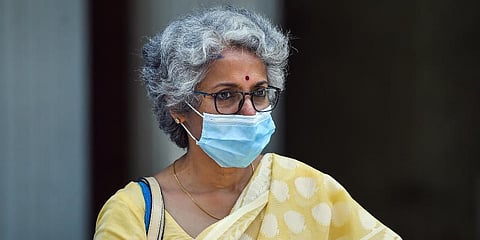

NEW DELHI: It surprised many when 63-year-old Dr Soumya Swaminathan, the World Health Organisation’s (WHO) Chief Scientist in Geneva, announced her exit on Twitter with a cryptic note two years ahead of her retirement.
However, her exit — a first in a series of high-profile departures from the global health body — came on expected lines as was anticipated as part of a post-pandemic shake-up in the WHO. Without specifying reasons for leaving, she later mentioned returning to India for more hands-on practical work in an interview.
Daughter of an illustrious father, MS Swaminathan, regarded as the father of India’s Green Revolution, it seemed natural for young Soumya to grow up as one of the world’s best scientific minds. Born on May 2, 1959, Soumya and her sisters — Madhura Swaminathan, a Professor of Economics at the Indian Statistical Institute, Bangalore, and Nitya Rao, a Senior Lecturer in Gender Analysis in International Development at the University of East Anglia, UK — not only used to frequent their father to his labs but would also accompany their mother to mobile creches for poor children of the construction workers.
She recalled when her father, hailed as a hero who turned India into a food-sufficient nation from a food importer, was attacked, by even his colleagues, when questions about the harmful effects of pesticides were raised. She said that it was this time that she learned from her father how to take criticism well.
It is no wonder that her early childhood not only fired her scientific temperament but also shaped her personality as she looked for solutions to the many problems the less fortunate faced — especially in health. She became a paediatrician and globally known clinical scientist for her research on tuberculosis and HIV.
She was always a studious child. A CBSE topper amongst girls in 1975, she did her schooling at Springdales, New Delhi. Her first choice was to become a veterinarian as she confessed that she loved animals, but when she found all her classmates were preparing for medical school, she also took a chance. She topped in Medicine at Armed Forces Medical College, Pune and then joined the prestigious All India Institute of Medical Science for an MD in Paediatrics.
She joined Children’s Hospital Los Angeles at the Keck School of Medicine of the University of Southern California, where she took a post-doctoral fellowship in neonatology and paediatric pulmonology from 1987 to 1989, where her passion for clinical research grew. She went on to work as a Research Fellow (Registrar) in the Department of Pediatric Respiratory Diseases at the University of Leicester in the UK.The mother of two has published over 350 peer-reviewed publications and book chapters.
As Director General of the Indian Council of Medical Research (ICMR) and Secretary of the Department of Health Research, Union Health Ministry, she got a chance to work with her father for the second time — the first time was when she won the national science talent test as a teenager — when they tried to develop interventional strategies to address the problem of under-nutrition and hidden hunger.
By then, she was already an inspiration and a role model for budding women scientists in India, but greater things awaited her. She was appointed Deputy Director General of the World Health Organisation in October 2017 and became the first Indian to hold the position at WHO. In March 2019, she became Chief Scientist at the world health body, overseeing the technical work and the new areas of digital health and innovation.
And then Covid happened. As the world grappled with the pandemic, she became one of the familiar and known faces globally — with her silver-grey hair, hand-woven saris and bindi — as she explained in a calm, poised manner during her regular bi-weekly press briefings on the pandemic. Without causing panic, she could give simple answers to complex questions.
Rightly described by some of her community members as an “unsung heroines” of the almost three years of fight against Covid, Dr Swaminathan, with her 30 years of experience, is sure to bring a wealth of scientific knowledge, evidence-based practice and clinical research to whatever assignment she takes up next — which she is yet to reveal.